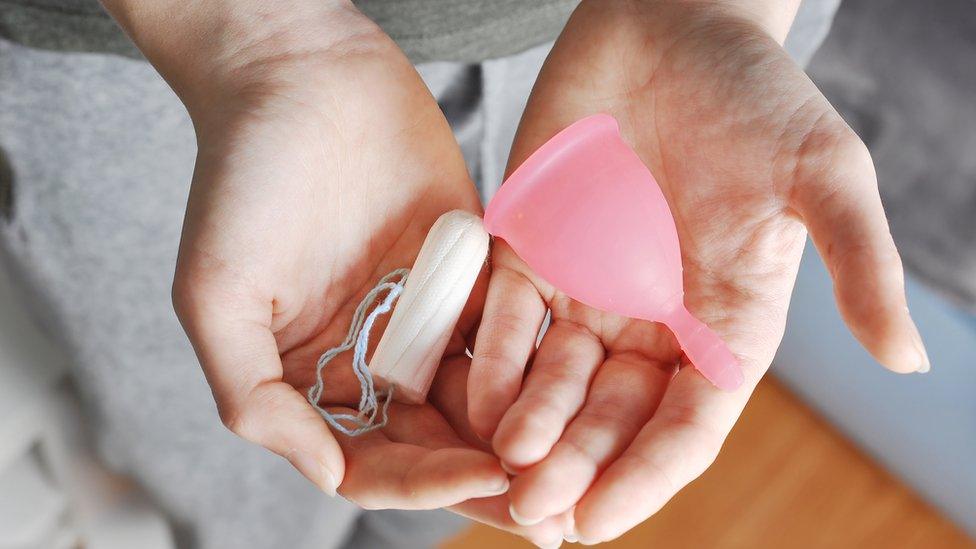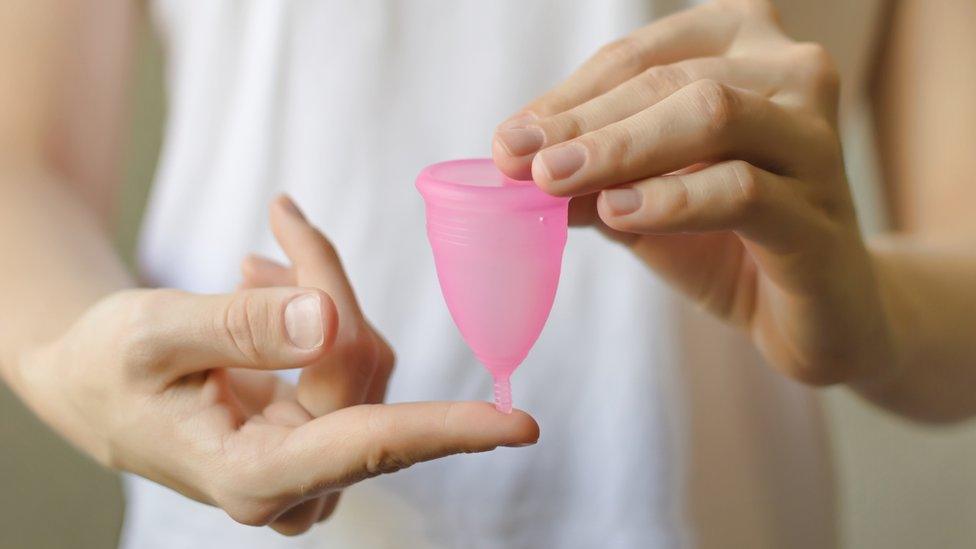Menstrual cups 'as reliable as tampons'
- Published

Women can be assured that menstrual cups are as leakproof as tampons and pads, say researchers who have carried out the first, large scientific review of sanitary products.
Menstrual cups collect rather than absorb period blood.
They fit into the vagina but, unlike tampons, are reusable.
Although they have been gaining in popularity, the review found awareness of menstrual cups among women was relatively low.
The work, published in the Lancet Public Health, external journal, looked at 43 studies involving 3,300 women and girls living in rich and poor countries.
Common concerns about trying a menstrual cup included pain and difficulty fitting or removing it, as well as leakage and chafing.
But the review found complications were rare.
Results from 13 of the studies found about 70% of women wanted to continue using menstrual cups once they were familiar with how they worked.
Four studies, involving nearly 300 women compared leakage between menstrual cups and disposable pads or tampons. Leakage was similar in three of the studies and significantly less among menstrual cups in one study.
How do they work?
Menstrual cups are made of soft, flexible material, such as rubber or silicone.
Once inserted into the vagina they create a suction seal to stop any seepage of blood.
They can collect more menstrual blood than tampons or sanitary pads, but need to be emptied and washed regularly.
There are two main types - a vaginal cup which is generally bell-shaped and sits lower in the vagina, and a cervical cup which is placed higher up, much like a diaphragm for contraception.

'I used one cup for over 20 years'
Catherina Petit-van Hoey, 62, who lives in Hemel Hempstead and Valencia, Spain, said she used a menstrual cup for decades since the late 1980s after hearing about it from a friend.
"It took some time to adjust, but when I got the hang of using it, I never looked back," she said.
"It was easy, I saved money and I did my bit to 'save' the environment."

Ms Petit-van Hoey said she gave cups to her daughters when they left for university, and "they realised how much money they saved"

She added: "I used one cup for all my periods over more than 20 years. I never sterilised it, but washed it well with soap, which may be questionable."
To wash it out while using public toilets, she said she sometimes used disabled toilets or "waited until I heard no-one at the public sinks".
Martina Fraternali, 31, from Manchester, said she has been using a cup for nearly 10 years and has "not once looked back".
"Yes at times it can be messy especially when you do not have a sink with clean water available at all times, but the costs and the environmental benefits of the cup outweigh it all.
"It's so convenient and comfortable that it feels like not wearing anything most times.
"I'd strongly recommend it and I'd go as far as saying that in this era of environmental concern, it should be a tax-deductible item and promoted as largely as other menstrual products".

How to use one
Find the right size cup to fit your body. The size does not relate to your menstrual flow.
Make sure the cup is clean and dry before use.
Kim and Amanda explain menstrual cups
Fold the cup and place it into the vagina where it can then unfold and form a leak-free seal.
To remove, squeeze the bottom of the cup to release the seal.
Empty the contents into the toilet and rinse or wipe the cup clean.
Sterilise the cup between periods.
Not a fan?
Lots of different brands are available to try, but a menstrual cup may not be for everyone. It can take several attempts to feel confident about using one.
Debra Holloway, gynaecology nurse consultant and member of the Royal College of Nursing said: "There's a whole range of products out there and it's worth persevering and finding the right thing that suits you."
What women use should be a personal choice, say experts. But better advice and evidence is needed to give them the information they need to make this decision.
Lead author of the research, Prof Penelope Phillips-Howard from the Liverpool School of Tropical Medicine, said: "Despite the fact that 1.9 billion women globally are of menstruating age - spending on average 65 days a year dealing with menstrual blood flow, few good quality studies exist that compare sanitary products."
Are they cheaper than tampons or sanitary towels?
Between the ages of 12 and 52, a woman who does not have children will have about 480 periods, according to the NHS.
A cup costs around £15 to £25, which is much more than a box of tampons, but it can be reused every month and lasts for up to 10 years, making it a cost-effective option in the long term.
Being reusable, rather than disposable, menstrual cups are also seen as a greener option for the environment than tampons and sanitary towels.
Reusable, washable menstrual underwear is also available.
How menstrual cups are helping to fight period poverty
The researchers believe that making menstrual cups available globally could help to tackle period poverty and health problems such as infections - even where water and toilet facilities are poor.

- Published4 October 2018

- Published1 May 2018

- Published13 March 2019
